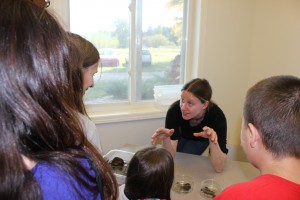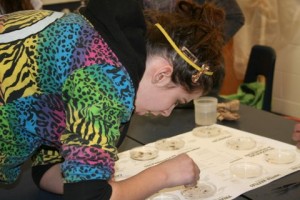Biodiversity Teaching Materials
Biodiversity: Research Professional Development Materials Assessments

Scientist Leila Desotelle talks with students about stream macro-invertebrates at Kellogg Biological Station.
Target Grades: Middle School and High School (modification suggestions for each level are included)
Description:Students will explore functional and taxonomic diversity in a stream ecosystem, learn about food web relationships, and learn about the ways in which abiotic and biotic factors determine what organisms are present in a community. Students will make and install leaf packs in a stream, wait for the leaf packs to be colonized by stream organisms, measure abiotic variables that could influence leaf pack colonization, retrieve the leaf packs and classify the organisms they find in both taxonomic and functional ways, and discuss how the leaf pack community is situated within a larger ecosystem.
Learning Goals: The purpose of this unit is to increase students’ ability to apply principles of biodiversity to their observations and reasoning about the natural world, using the freshwater stream ecosystem as the context for learning. This unit focuses on the following principles of biodiversity:
- Organisms vary genetically, thus also vary phenotypically & functionally
- Ecological communities are constrained and shaped by: Biotic resources & interactions, Abiotic resources & conditions, and Dispersal
- Matter and Energy are finite in space and time, and organisms interact with and impact matter and energy resources.

High School Lesson Plan – This document includes Teacher Notes, Student Worksheets, Teacher Answer Keys, and additional handouts. Power points and other resources can be found below. Appendices: including optional lesson plans.
Middle School Lesson Plan – The middle school version focuses on food web relationships, taxonomic diversity, and classification. It includes a vocabulary introduction to biodiversity and fewer lessons that involve integrating math, connections with the abiotic factors in a community, and functional redundancy. This document includes Teacher Notes, Student Worksheets, Teacher Answer Keys, and additional handouts. Power points and other resources can be found below. Student Workbook includes student pages and handouts. Appendices: including optional lesson plans.
Assessments — Assessments include student tests, teacher tests, and interview protocols. There are separate tests available for middle school and high school students.
Additional Support Materials for Lessons
Posters and sorting cards:
- Bird Population Maps (For Lesson 4)
- Organism sorting cards (For lessons 6, 9, 10, and 11) Sorting cards for students to use with the three posters below. There are smaller versions for student desk work and larger versions whole class board work.
- Food Web Poster– (for Lessons 5 &11) This food web diagram will help scaffold student understanding of the feeding relationships between organism groups in a stream ecosystem. More advanced students may not need this tool, although it might be a useful organizing framework. Food web templates to print onh 8.5″x11″ sheets or to project or print in large format for board work. Two scaffoldings included: 1 with some matter and energy transfer arrows included and 1 with none.
- Powers of 10 Poster (For optional lesson D) This diagram is designed to help students understand the relative sizes of organisms identified in the leaf pack.
- Classification Poster (For Lesson 9) This phylogeny based diagram of organismal relatedness is designed to help scaffold student understanding of the evolutionary relationships between organism groups in a stream ecosystem. Large Classification Poster for board work to project or print large scale. Classification poster for each student group, print on 2 “11 by 17” sheets or 4 “8.5 by 11” and tape together.
- Biodiversity: Life in a Drop of Water (for Lesson 5-Middle School)
This provides a simple key to organizing smaller organisms in water samples.
Power Point Presentations
- Biodiversity Introduction PowerPoint Slide Presentation– (for Lesson 1(MS)) This power point introduces the key vocabulary used in the unit and the experimental design.
- Biodiversity PowerPoint Slide Presentation– (for Lesson 2(MS)) This power point is used to focus on the experiment that will be done in the stream, and should be modified for your site as appropriate.
- Feeding Groups Power Point Slide Presentation– (For Lesson 4 (MS) and 6 (HS)) This PowerPoint introduces different feedings strategies, helps students see the different types of mouthparts present on stream invertebrates, and helps them think about how mouthparts are related to functional feeding groups.
- Decomposer Power Point Slide Presentation – (For Lesson 5 (MS) and 8 (HS)) This PowerPoint presentation contains pictures and information about different groups of microscopic decomposer organisms that are likely present in the leaf packs. It is focused primarily on bacteria and fungi and how microorganisms acquire resources (food).
- Teacher Food Book Power Point Slide Presentation– (for Lesson 7(MS))
This PowerPoint provides a teacher answer key for the Food Book activity in Lesson 7. - Biological Classification Power Point Slide Presentation– (For Lesson 9(HS)) This PowerPoint presentation contains an introduction to biological classification and what it means for organisms to be related.
Excel Templates
- Graphing Template (For Lessons 5 & 7)
- Example leaf pack Data (For Lessons 5 & 7)
- Beans example Template (For Lesson 7)
- Shannon Index Template (For Lesson 12)
Development of these materials was supported by a grant from the National Science Foundation: Targeted Partnership: Culturally relevant ecology, learning progressions and environmental literacy (NSF-0832173). Any opinions, findings, and conclusions or recommendations expressed in this material are those of the author(s) and do not necessarily reflect the views of the National Science Foundation.